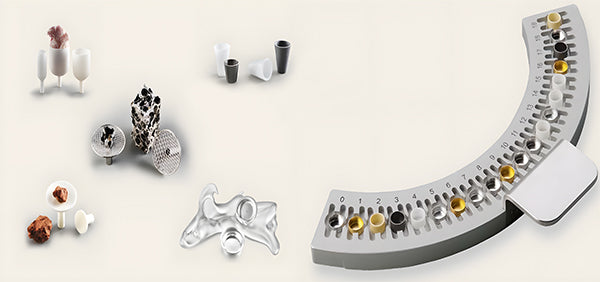
Why Do My Thermal Analysis Results Vary? It Could Be the Crucible
Inconsistent thermal analysis data is frustrating. You might blame instruments or method settings. But have you checked the crucible?
Using the wrong crucible—wrong material, shape, or even lid—can lead to unstable baselines, peak shifts, poor thermal contact, and unreliable DSC or TGA results.

At first, I underestimated the role crucibles played in analysis precision. Over time, I noticed strange fluctuations in baseline repeatability, especially when switching crucible batches. That’s when I started testing variables one by one—and found how small crucible inconsistencies caused huge analytical errors.
Can a mismatched crucible affect DSC baseline stability?
You set up the DSC test precisely. The heating program is right. But your baseline wanders. What’s happening?
A mismatched crucible—especially one with poor thermal contact or size variance—can create temperature gradients. These gradients cause unstable heat flow, which shows up as drifting baselines on your DSC results.
How does crucible compatibility affect thermal balance?
Baseline stability in DSC relies on precise thermal contact between the crucible and sample platform. If the crucible is too small or has uneven bottom curvature, uniform heating is lost. This causes apparent shifts in the baseline due to delayed or erratic heat flow response.
I once tested a platinum crucible meant for a TA Instruments analyzer on a Shimadzu DSC. While it fit physically, the contact was imperfect. As a result, the pre-melting baseline showed a slope that shouldn’t be there. Switching to a TA-compatible crucible from labshopx fixed the issue instantly.
| Crucible Issue | Effect on Baseline |
|---|---|
| Loose Fit | Temperature delay, drifting baseline |
| Wrong Lid Contact | Uneven pressure, signal fluctuation |
| Non-uniform Bottom | Poor thermal transfer |
How do impurities in crucible materials alter test results?
Even with a perfect fit, crucibles can still be trouble. Impurities in the crucible material itself introduce unexpected thermal events during analysis.
Elements like silicon or iron in ceramic crucibles may degrade at high temperatures. These reactions can release gases or react with the sample, distorting true sample behavior in DSC or TGA curves.
Why purity level in crucibles affects thermal integrity?
Sub-standard crucible materials lead to contamination or unexpected thermal reactions. For instance, low-grade aluminum crucibles may contain trace oxidants. During a TGA run at >600°C, these oxidants react, generating noise or adding mass loss steps not from the sample itself.
I once ran a DSC test for a pharmaceutical API using a third-party ceramic crucible. The endothermic peak came early and broader than usual. Turns out the crucible material was reacting slightly below testing temperature—introducing false endothermic signals.
| Material Impurity | Result Distortion |
|---|---|
| Residual organics in alumina | Unexpected exothermic peaks |
| Metal traces (Fe, Ni) | Redox activity, data inconsistency |
| Silica filler | Thermal expansion damage at high temp |
What causes thermal lag in crucibles during measurement?
You set up everything right, yet your melting point appears slightly off. This could mean your crucible has a thermal lag problem.
Thermal lag occurs when the heat doesn’t reach the sample in sync with the programmed temperature ramp. This is often caused by thick-walled crucibles or poor thermal conductors like budget ceramics.
What affects a crucible’s heating response rate?
Thermal lag is tied to three parameters: wall thickness, thermal conductivity, and surface contact area. For example, a thick ceramic crucible has low conductivity and high heat capacity. It stores heat, then slowly passes it to the sample. This delay bends heat flow curves and shifts peak temperatures from the actual melting point.
During lithium battery material screening, I noticed such lag using a high-capacity crucible meant for a slower ramp. Switching to a thinner sapphire crucible cut the response delay significantly. The correct melting onset came back, matching literature values.
| Crucible Property | Thermal Lag Impact |
|---|---|
| Thick wall | Reduced heat transfer rate |
| Low conductivity (e.g. alumina) | Delayed peak shifts |
| Poor bottom contact area | Uneven heating |
Should I calibrate devices for each crucible type?
It’s tempting to skip calibration when switching crucible types, especially across batches. But that’s risky if precision matters.
Each crucible type, by mass and conductivity, shifts your system’s heat response. You must calibrate for accurate heat flow, baseline shape, and repeatability. One crucible’s “zero drift” may be another’s noiseline.
Why calibration for crucibles is essential?
Even in the same material family (aluminum, for example), small shape or diameter differences can shift calibration curves. Mass also varies. One ceramic pan might weigh 14.7 mg, another 15.3 mg. Calorimetric sensitivity assumes a constant heat sink—if it changes, so should your reference curve.
Most instruments, like Mettler Toledo DSCs, allow multi-point calibration. Use indium or tin standards for temperature and enthalpy checks. Do it any time you switch to a new batch, shape, or source of crucibles.
| Calibration Parameter | Why It Matters |
|---|---|
| Onset temperature (using indium) | Corrects heat lag variation |
| Enthalpy standard (e.g., tin) | Balances heat flow sensitivity |
| Mass offset | Compensates for pan variability |
Conclusion
The crucible you use affects more than you think—baseline drift, response speed, and even phase change peaks. Use certified pans and always recalibrate.

Leave a comment